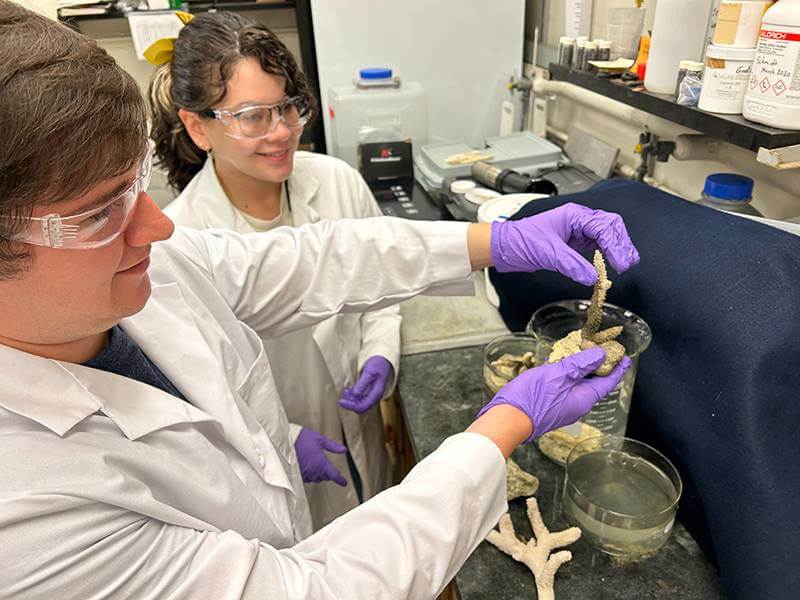Patent-pending adhesive formulations developed at Purdue University from fully sustainable, bio-based components establish bonds that grow stronger when underwater or exposed to wet conditions.
Gudrun Schmidt, an associate professor of practice in Purdue’s Department of Chemistry, and a team of researchers developed the formulations from zein, a protein found in corn, and tannic acid. A paper about the team’s research was published in the peer-reviewed journal ACS Applied Materials & Interfaces.
The adhesive formulations could be further developed and used in the restoration of coral reefs and have applications in the construction, manufacturing, biomedical, dental, food and cosmetic industries.
Stronger in water
Schmidt and her colleagues conducted underwater adhesive experiments on their formulations, using different surfaces and different waters, including seawater, saline solution, tap water and deionized water.
“Interestingly, the water type does not influence performance a great deal, but the substrate type does,” Schmidt said. “An additional unexpected result was bond strengths increasing over time when exposed to water, contradicting general experiments of working with traditional, petroleum-based glues. Initial adhesion underwater was stronger compared to benchtop adhesion, suggesting that water helps to make the glue stick underwater.”
Protective skin formed on the surface of the adhesives when placed underwater, which kept water from entering the rest of the material immediately.
“But once the skin was in place, it could be broken to induce faster bond formation,” Schmidt said.
The experiments also indicated maximum bonding at about 30 degrees Celsius, then another increase at higher temperatures.
Schmidt said the process to make the adhesive formulations is a short one.
“We can use inexpensive, sustainably sourced, plant-based materials to make gallons of glue within hours,” Schmidt said. “The adhesives are very simple to make in the lab or outdoors, everywhere on the planet.”
The demand for nontoxic formulations
Schmidt said other researchers are formulating adhesives that mimic the glues used by mussels, barnacles, oysters and sandcastle worms to adhere to the seafloor and other wet surfaces. Those best-performing formulations, however, are fully synthetic.
“Lengthy syntheses with the use of harsh chemicals may hold back their future development,” Schmidt said. “Nontoxicity, sustainably sourced materials and minimal environmental impact are increasingly in demand. Consequently, several groups have turned to developing new and remaking old adhesive systems using bioinspired or bio-based chemistry.”
The increased demand of nontoxic materials has led to creating adhesives for biomedical applications. The resulting glues have properties similar to soft tissue. Schmidt said that bio-based adhesives have further applications.
“Once the in vivo and biomedical realm is left behind, there is an entire world of other applications requiring metals, plastics, wood and inorganic substrates that need adhesives to work in the presence of water,” Schmidt said. “Food, oral and cosmetic applications are less restrictive when it comes to purity of starting materials. Food-grade polymers can often be used for making wet adhesives. We also are working on dental applications, trying to make bonds in this wet and challenging environment.”
Coral reef restoration
Schmidt said another particularly intriguing application for the patent-pending Purdue-developed adhesive formulations is the restoration of coral reefs.
“There are several major efforts, worldwide, planting young corals to replace those structures that are already dead,” Schmidt said. “A major hindrance to these efforts is lack of suitable underwater adhesives that work well for this application.”
Schmidt and her research team are working with the Coral Restoration Foundation, sending various formulations to be tested.
“We recently visited the Florida Keys to test a few formulations in bucketsful of ocean water,” Schmidt said. “It is great to see our work outside of the research lab and in the real, wet world.”
The Coral Restoration Foundation constantly searches for the most efficient and effective method of outplanting coral onto reef sites, said Phanor H. Montoya-Maya, coral restoration program manager at CRF.
“Having different alternatives means different species and habitats can be outplanted with positive results,” Montoya-Maya said. “Science collaborations like this allow us to test and fine-tune methods before mainstream restoration. Field preliminary results are very encouraging, and we’ll continue to provide feedback to Purdue researchers to ensure the final product is consistently successful across multiple restoration goals.”
Schmidt disclosed the adhesive formulations to the Purdue Innovates Office of Technology Commercialization, which has applied for a patent to protect the intellectual property.
About Purdue University
Purdue University is a public research institution with excellence at scale. Ranked among top 10 public universities and with two colleges in the top 4 in the United States, Purdue discovers and disseminates knowledge with a quality and at a scale second to none. More than 105,000 students study at Purdue across modalities and locations, with 50,000 in person on the West Lafayette campus. Committed to affordability and accessibility, Purdue’s main campus has frozen tuition 12 years in a row. See how Purdue never stops in the persistent pursuit of the next giant leap, including its first comprehensive urban campus in Indianapolis, the new Mitchell E. Daniels, Jr. School of Business, and Purdue Computes, at https://www.purdue.edu/president/strategic-initiatives.
If our reporting has informed or inspired you, please consider making a donation. Every contribution, no matter the size, empowers us to continue delivering accurate, engaging, and trustworthy science and medical news. Independent journalism requires time, effort, and resources—your support ensures we can keep uncovering the stories that matter most to you.
Join us in making knowledge accessible and impactful. Thank you for standing with us!

